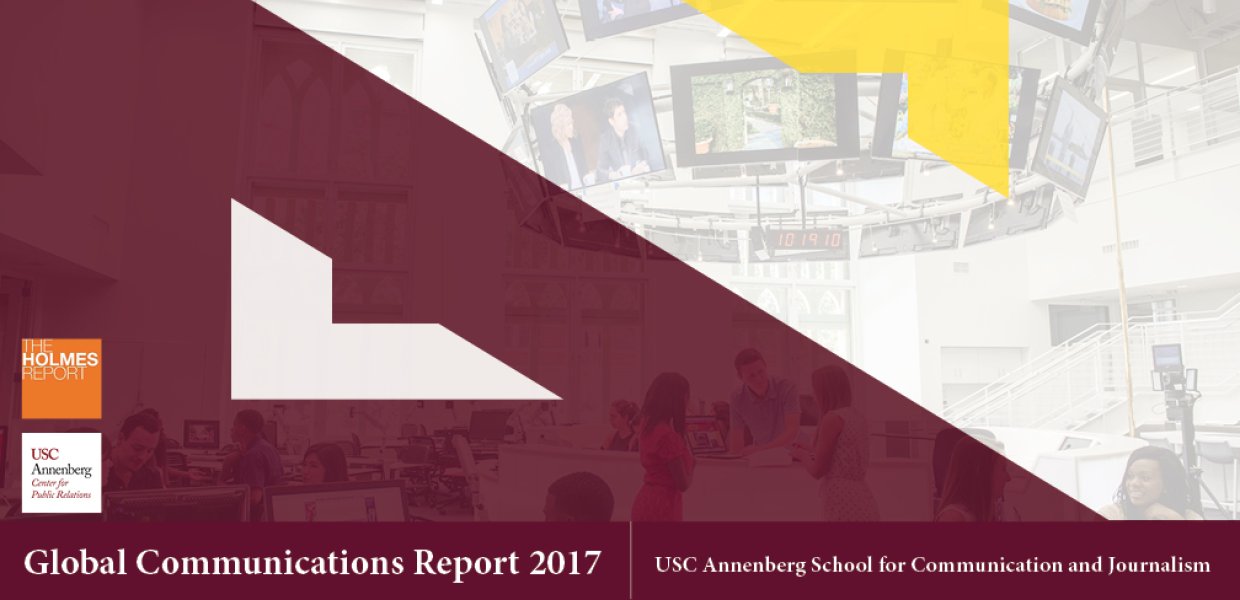87% of PR executives believe the term “public relations” does not describe their future.
The USC Annenberg Center for Public Relations (CPR) has released key findings from its second annual Global Communications Report (GCR17), a comprehensive survey of more than 800 public relations executives from around the world. For the first time ever, the report also features insights from almost 700 public relations and communications students, along with in-house marketing executives.
A key finding from this year’s study is the degree to which the public relations function is converging with marketing. Almost half of PR professionals included in the study predict that public relations will become more aligned with marketing over the next five years. In a surprising turn, only 8 % of PR professionals believe that PR will be a distinct and separate function. When marketers were asked the same question, 57% were convinced that the two functions would be more aligned in the future, with 20% predicting PR will become a subset of marketing.
“Monitoring this trend toward convergence, and understanding its implications, is one of the most critical issues facing the public relations industry today,” said Fred Cook, Director of the USC Center for Public Relations and Chairman of Golin, a leading PR firm. “We’re seeing a lot consolidation on both the agency and corporate fronts, which has the potential to diminish the role of the PR professional.”
Complicating matters, 87% of PR executives believe the term “public relations” won’t accurately describe the work they will be doing in five years. Almost half believe PR needs to be more broadly defined, while the rest think the name should be changed. Interestingly, not-yet-jaded students are far more comfortable with the current terminology than seasoned pros. Fewer than 20% think the name needs to be changed and 85% are relatively comfortable explaining it.
When it comes to trends that will be most important over the next five years, digital storytelling ranked above all others, followed by social listening, social purpose and big data. The combination of these items illustrates the rapid change that the industry has seen in recent times. Emerging technologies like virtual reality and artificial intelligence fell farther down the list of key trends that will play a vital role, while fake news and Donald Trump were ranked at the bottom.
The differentiation between paid and earned content is another issue that was illuminated by the report. As last year’s study indicated, earned media will continue to decline as a source of PR agency revenue, while paid, shared and owned media will increase. Similarly, in-house executives predict that over the next five years they will devote more resources to owned channels than to earned channels. Supporting that direction, 60% of all PR executives believe that branded content and influencer marketing, which are both primarily paid, will be important trends in the next five years. More importantly, as the lines blur between media formats, over 50% of PR professionals believe that in the future the average consumer will not make a distinction between paid, earned, shared and owned media.
“PR has the opportunity to move aggressively into paid content, an arena long dominated by advertising but that will require investment and training,” said Paul Holmes, Founder and Chair of The Holmes Report, which co-sponsored the study. “The bigger challenge for the profession and for society is what happens when consumers no longer know the source or the nature of the information they receive, and how that impacts the credibility of that information.”
Despite a few challenges, almost all (92%) of agency executives predict growth in the next five years, while 70% of in-house executives predict an increase in their budgets and headcounts. But for the second year in a row, recruiting and retaining the right talent are the greatest obstacles to achieving this growth. However, Annenberg’s first-ever student survey found a diverse group of future PR leaders who are tuned in to the trends and technologies impacting communications and are reasonably well prepared to tackle them. These new recruits also bring a sense of social purpose and pride to the profession. They just want a better definition of their role and a little more money.
“Our study raises some critical questions about the future of communications and the role of the PR professional, and we may have to wait until next year to see how they pan out,” said Cook. “But one thing is perfectly clear. There’s never been a more interesting time to work in public relations or whatever we will call it in the future.”
About the Global Communications Report
The annual Global Communications Report is conducted by USC Center for Public Relations, in conjunction with The Holmes Report, the Arthur W. Page Society, the Institute for Public Relations, the Global Alliance for Public Relations and Communication Management, ICCO, the International Association for Measurement and Evaluation of Communication, the PR Council, PRCA, the Worldcom PR Group, PRSSA and PRSA. It is designed to provide insight into the evolution of the global communications industry by analyzing emerging trends.
About USC Annenberg Center for Public Relations (CPR)
Based at the USC Annenberg School for Communication and Journalism in the heart of Los Angeles, the USC Center for Public Relations (CPR) is truly at the center of one of the world’s most dynamic professions. Our mission is to connect corporations, agencies, academics and students to define the future of our industry and to develop those who will shape it. Follow CPR @Center4PR and #PRFUTURE.








